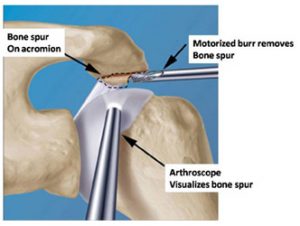Arthroscopic Subacromial Decompression
About your shoulder
Shoulder joint is a ball on the top of your arm bone and socket which is a part of the shoulder blade. Above the ball and socket, joint is a ligament that is attached to a bony prominence on your shoulder blade. This forms an arch. The area between the arch and shoulder joint is known as sub-acromial space.
To move your shoulder up and down, a group of muscles and tendons known as rotator cuff pass through this arch.
Above the rotator cuff is the small bursa which cushions it from the roof.
When you move your arm away from your side, the rotator cuff keeps the ball centered in the socket. When your arm reaches shoulder height(horizontal), the sub-acromial space is narrowed.


What is impingement?
The rotator cuff appears to be vulnerable to tendon damage or degeneration in the sub-acromial space. Damage to tendon can range from inflammation to tears. Once the tendon becomes affected, it swells, filling more of the space, which increases the chances of tendon and bursa becoming pinched. This is known as ‘impingement’. Anything which narrows the space between the rotator cuff and arch above, will tend to pinch and irritate the cuff. Tears in the tendon can occur from sudden injuries such as falling, but more commonly they develop gradually, as wear and tear effect on the tendon. This is partly age related, but may result from longstanding impingement.
What are the symptoms?
The main complaint is pain, often felt on the outside of upper arm. A classical presentation is of painful arc on movement when the arm is lifted out to mthe side and up to your ear. Pain is felt on twisting movements such as putting jackets and coats on. Pain may occur at night when your arm is resting (during active inflammation).
Why does it occur?
The exact cause is unknown. It appears that some people may be susceptible to a wear and tear process in the tendon. The problem appears to be within the tendon and it starts to fray and split. Mechanical triggers (i.e. changes in posture or activity) where the tendon is stressed, may then cause episodes of pain.
What tests may be done?
The main way we diagnose shoulder impingement is from your symptoms and by examining your shoulder. X-rays are taken to look for any bony pathology and does not show muscle inflammation or wear and tear. MRI is done to look for muscle inflammation or tendon tear.
What are your treatment options?
Non-surgical treatments
1) Injections: These injections are given into the sub-acromial space aiming for the bursa not the tendon itself. Usually a mixture of local anaesthetic and steroid is given, form the back of the joint.
2) Physiotherapy: It includes exercises to strengthen the muscles around your shoulder blade, improve your posture, stretching and strengthen your rotator cuff. Although the exercises may be a hard work, tight or uncomfortable, they should not be painful. If you are unable to do any form of exercise because of pain, the physiotherapist may offer treatments such as ultrasound and laser. It is difficult to prove that these work, but they rarely cause worsening symptoms.
3) Surgical treatment: If your symptoms do not settle with the above measures, an operation may be suggested. The operation done most frequently is a ‘sub acromial decompression’. This is done by keyhole surgery (arthroscopy). The operation involves cutting the ligament and shaving away part of the prominence on underneath of the acromian bone. This aims to increase the size of sub-acromial space. If the rotator cuff is torn, the surgeon may be able to repair it. rehabilitation after the repair operation is longer than after decompression alone.

